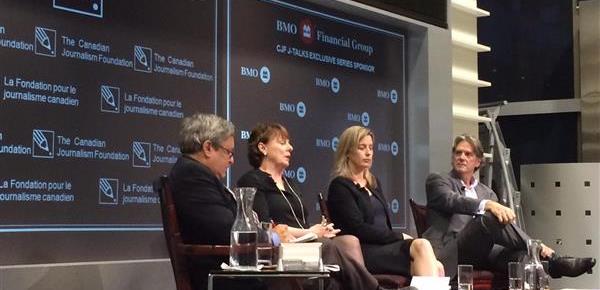Native advertising. Branded content. Custom content. Content Marketing. Paid Content. Whatever term you want to use to describe it, news organizations see allowing brands access to their audience with content as the latest and best business strategy. But is it working, business-wise? Is it worth it for them, editorially speaking?
This was the topic of conversation at Thursday night’s J-Talk, put on by the Canadian Journalism Foundation at the TMX Broadcast Centre in Toronto. The conversation featured (from left to right in the photo above) Ryerson School of Journalism chair and moderator for the evening Ivor Shapiro, Star Media Group Executive Director of Content Development Cathrin Bradbury, The Globe and Mail Executive Editor Jill Borra, and Postmedia Vice President of Content Strategy and Business Development Scott White.
What is ‘paid content’?
It became clear that in order to have a discussion about news organizations’ relationships with brands, advertisers and content, we would first need to sort out terminology. After using native advertising, branded content and custom content interchangeably, the panel settled on using “paid content” to refer to these relationships.
As the conversation continued, though, it became evident that, among the news executives on stage, despite a consensus on terminology, there was no consensus on what paid content is, what it looks like, how to handle it next to editorial content and how media companies can fuel this revenue stream going forward. (It is the only growing revenue stream, Borra said.)
"There is no standard definition," of native advertising, says Scott White. (If we don't know what's what, how can readers?) #cjfjtalk
— Simon Houpt (@simonhoupt) October 2, 2014
For example, Borra explained The Globe has four different ways it sells ads related to its content:
Custom content: Advertisers buy space around certain types of content, but do not see or touch content before it’s published. Globe has been doing this for 10 years.
Advertorial: Advertiser (or contractor from ad department) produces this content. Editorial or custom content team does not touch it.
Branded content: Brands approach Globe to produce content for them, but the content never shows up in the Globe alongside editorial (It’s separate, like a standalone magazine. This might be a mag distributed in the Globe, though.)
Native advertising: Strictly digital. Advertiser content overseen by management, not newsroom staff. It shows up in the flow, in a spot on the website. It’s shaded, labeled sponsored content on the article page.
But she raised the concern about their approach and delivery of the content. She said The Globe has had troubles with labeling it clearly in the past. It’s something they’re working to fix and become more consistent with, though. White chimed in, noting that it would be beneficial for news as a whole if there were an industry standard for labeling paid content; it would serve the public better.
How does paid content perform?
The panel discussed specific examples of paid content measurement. The conclusion: in some cases, it performed very well. Bradbury cited the Orange is the New Black-sponsored paid post in the New York Times. Which didn’t mention Netflix, but was instead all about female inmates and the prison system.
David Carr praised it, on Twitter. Or, what we imagine is the closest to praise, anyway.
All brand-sponsored journalism does not suck. Witness this peach by @mdeziel on women in prison. From Netflix, natch. http://t.co/Jljr6MvzpP
— david carr (@carr2n) June 13, 2014
What it boils down to, whether it’s content produced by a brand or content produced by a journalist is, of course: Is the content good? Is it informative for the audience? Is it about a topic that is of interest to the brand (journalistic or otherwise)?
A brand-news relationship that works
The panel didn’t spend much time discussing the logistics of making the relationship work, but White noted that paid content from a brand in a news organization, if done right, should not erode the audience. No advertiser would want to buy content space in a publication that does a poor job of executing this strategy.
So who is doing it well?
Going native: How Quartz and GE are making content marketing work
When brands become publishers and native advertisements become big business, there is a secret to doing both well.
In this post on TheMediaBriefing, GE director of Global Media Strategy Jason Hill and Quartz EMEA Simon Davies, explain what made their sponsored content/native advertising/content marketing work. (GE sponsored Quartz’s launch in India)
“Transparency. Do not try to fool your readers. Users will call you out on it and in a meritocratic world that won’t be good for you. Above and beyond that, I don’t understand an advertising partner that wants to blur the line.”
— Simon Davies, EMEA executive director, Quartz
Brands as publishers?
The idea of brands driving revenue for news organizations through content was a central focus for the panel. But how sustainable is this when brands can execute their own publishing, their own promotion and start building their own relationships with an audience? It was a topic ignored, so I sent my question to these news execs via Twitter.
How will newspapers going to compete for brand content dollars once brands figure out publishing/audience on their own? #cjfjtalk
— Belinda Alzner (@belindaalzner) October 2, 2014
Each news executive was able to answer, noting what sets their products apart. Borra said that the key differentiator that legacy news organizations have when it comes to selling this space to brands continues to be the built-in, loyal audience. Bradbury discussed the possibility of having journalists create the brand content (as per The Globe’s definition of “branded content”) because of journalists’ well-honed storytelling skills. Then there’s the presentation of that content. White pointed out that the news platform can lend themselves to sophisticated storytelling, the way Netflix did with OITNB.
Bradbury notes that journalists still tell stories best, so they can sell that angle to brands. #cjfjtalk
— Belinda Alzner (@belindaalzner) October 2, 2014
White says that it gives opportunity to give more sophisticated things with the stories, like what NYT did with Netflix.
— Belinda Alzner (@belindaalzner) October 2, 2014
Borra points out that brands can produce content, but they don't have the audience that news orgs do. #cjfjtalk
— Belinda Alzner (@belindaalzner) October 2, 2014
Is paid content journalism’s saviour or sellout?
That was the question that framed the evening, and after an hour and a half of panel discussion and audience Q&A, the answer was not made obvious.
What is obvious, though, is that news organizations see value in these content-based advertising deals. But with brands increasingly moving into the publishing space themselves and cutting out the traditional media middleman, the future of the relationship between news, advertisers and content remains to be seen.








